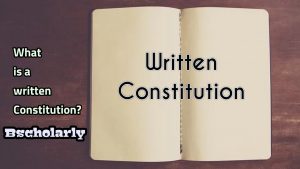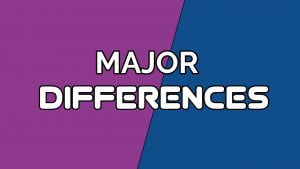From the word “Written” and “Unwritten“, one might think that the only difference between a written and unwritten constitution is the fact that one is written down whereas the other is not written down, but that is not totally correct. Sometimes, even an unwritten constitution is written down too. Take for instance, the constitution of Britain is written down but still referred to as an unwritten constitution. This is why many scholars say that it is actually difficult to differentiate between the two.

In this article, we will be looking deeply into the differences between a written and unwritten constitution. In other words, I will explain the core differences or areas of differences between this two types of constitution. It is therefore advisable to read this work carefully if you want to grasp everything I am going to share today.
But before going into the crux of this work, let’s quickly look at the meaning and features of a written and unwritten constitution. It will help you to understand their differences.
Also see: Characteristics of a good constitution
Meaning of a written constitution
A constitution is said to be written when the whole body of fundamental laws, customs, convictions, principles, rules and regulations according to which a particular government of a country operates are written or documented down.
This implies that a written constitution can be found in a single document. Some changes like revolution, war, coup d’etat, gaining of independence, etc, that may take place in a country may warrant the writing down of a country’s constitution.
Countries like U.S.A, Nigeria, India, France, Canada, Ghana, Sierra Leone, Gambia and many other countries of the world have written constitutions.
Also see: Best places to purchase lawyer’s wig and gown in Nigeria
Features of a written constitution
1. It is written or documented down in a single document:
2. A written constitution has a preamble or introduction which expresses the essence of the constitution.
3. It stipulates the methods and conditions for its amendment and change.
4. A written constitution looks very simple because, it can be obtained in a single document.
5. It spells out the fundamental human rights and duties of the citizens of a country.
6. It states and defines the organs of government, their functions and relationship.
7. A written constitution is usually rigid in nature.
Also see: Differences between Cross-offers and counter-offers
Meaning of an unwritten constitution
A constitution is said to be unwritten when the whole body of fundamental laws, customs, convictions, principles, rules and regulations according to which a particular government of a country operates are not written down or codified in a single document. Unwritten constitution seems to be the opposite of written constitution.
Britain and New Zealand are good examples of countries that have unwritten constitution. An unwritten constitution is not synonymous with non-existent laws but what it means is that these laws, customs, etc, cannot be obtained from one single book or document.
Also see: Differences between political party and pressure group
Features of an unwritten constitution
1. It is not contained in a single document.
2. It is easier to amend since its mode of ammendment is not expressly provided in any particular law
3. The laws are scattered across many documents thus making it very difficult to interpret an unwritten constitution.
4. Unwritten constitution grow with the people. It is usually dynamic in nature.

Also see: Most lucrative areas of law for law students to study
Major differences between a written and unwritten constitution
1. A written constitution is contained in a single document while an unwritten constitution is not.
2. While a written constitution is rigid, an unwritten constitution is flexible.
3. Written constitution stipulates the methods and conditions for its amendment and change while an unwritten constitution does not.
4. A written constitution is more complex than an unwritten constitution because many law are contained in it.
5. While a written constitution has a preamble or introduction that expresses the essence of the constitution, an unwritten constitution has not.
6. A written constitution spells out the fundamental human rights and duties of the citizens in one document, while an unwritten constitution does not.
7. The organs of government, their functions and relationship are clearly stated and defined in a written constitution more than an unwritten constitution.
8. A written constitution removes constitutional ambiguities whereas an unwritten constitution is surrounded with ambiguities because it is scattered across different documents.
9. It is easier to ascertain unconstitutional acts of rulers in a written constitution than in an unwritten constitution.
10. Citizens can easily know when their rights are violated in a written constitution than in an unwritten constitution.
11. While a written constitution makes it difficult for the emergence of dictatorial rulers, an unwritten constitution makes it easier.
12. A written constitution ensures political stability more than an unwritten constitution.
13. An unwritten constitution adapts to a country’s changing socio political and economic situations more than a written constitution.
14. While an unwritten constitution develops from many years of practical experiences of the people and government of a country, a written constitution does not.
15. Constant litigations are more frequent in a written constitution than an unwritten constitution.
Kindly check the video below for more differences between a written and and unwritten constitution:
So far we have looked at the meaning, features and differences between a written and unwritten constitution. With what I have here, I strongly believe that you now understand how a written constitution is different from an unwritten constitution. Meanwhile, if you still have any problem on this topic, don’t hesitate to drop it in the comment section.

Edeh Samuel Chukwuemeka, ACMC, is a lawyer and a certified mediator/conciliator in Nigeria. He is also a developer with knowledge in various programming languages. Samuel is determined to leverage his skills in technology, SEO, and legal practice to revolutionize the legal profession worldwide by creating web and mobile applications that simplify legal research. Sam is also passionate about educating and providing valuable information to people.